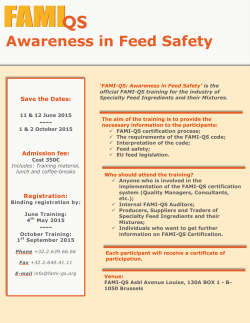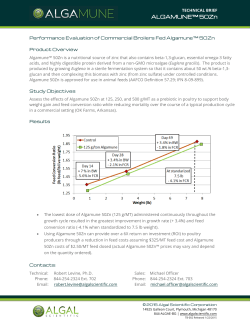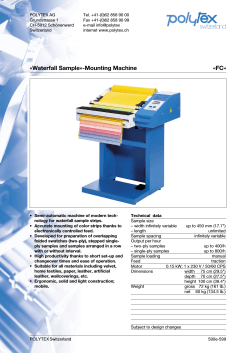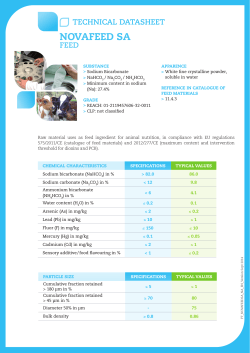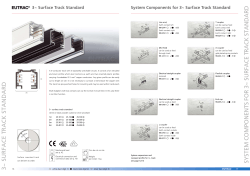
9. Feed efficiency - Bpex
Knowledge transfer bulletin Feed efficiency: Onfarm checks Although actual feed prices are largely beyond your control, there are a number of routine checks that you can complete on your unit to assess efficiency. It is likely that you will be doing a number of these already, but take the time to specifically look around your unit and double check that this is actually the case, as 5 20% of feed is often wasted on a typical farrow to finish unit! Feeding space Vermin & birds Is there adequate feeder/hopper space for the number and size of pigs in the pen, take time to look, are pigs crowding around the feed hopper or trough? See overleaf for guidance. Is there evidence of rodents and/or birds on your unit? Look again at rodent and bird control. When was the last time the bait was changed, is it time to change it? Not only are vermin a health risk, but they can also lead to expensive feed waste. Feed flow rates Are all the hoppers working correctly? Adjust the feeder flow rates to maintain intake but reduce wastage. Depending on the hopper, flow rates may need to be adjusted as the pigs grow. Check each hopper to ensure that the feeding system works. Feed quality The presence of dust, “fines” or lumps of clogged feed will reduce feed intake. Check if the hopper or auger mechanism is damaging/crushing the feed or affecting the pellet size, increasing wastage. Try using a Bygholm sieve to check particle size, ask BPEX for more information. Temperature Monitor the daily min/max temperatures within buildings. High temperatures reduce the appetite and therefore growth rate of pigs. Cold temperatures cause pigs to use energy to maintain body heat, rather than using it to grow. See overleaf for recommended temperatures. Water Check water availability and flow rates. Water intake drives feed intake and therefore affects growth rate and FCR. See overleaf for recommended flow rates and water requirements. Are there sufficient functioning drinkers, providing a ready source of clean water, ie at Feed storage least one nipple drinker per 10 pigs? Inspect bins and check feed for signs of mould and Check flow rates, you just need a measuring mites. If found, identify the source, eg clogged feed jug/cylinder and a watch. Adequate flow rates in the hopper or poor storage (ie damp and humid). are as essential as the number of drinkers. If mould is present discard the affected feed and Are drinkers at the correct height for stage of take remedial actions immediately. pigs and are they correctly positioned to allow ready access? Spillage How much feed is being wasted from falling down between the slats or being spilt onto the floor around the trough and spoilt? This is expensive wastage. Identify why it is happening; is the hopper design incorrect for the size of pig, is overstocking causing uneven feeding, do feeder flow rates require adjustment or do the feed hoppers or feed system require repair? Fighting Feed orders Hygiene Is there evidence of ear biting or fresh shoulder scars in the group from fighting at or around the feeder? This is an indication that there may not be enough feeding space or that hopper placement/access is inadequate and requires improvement. Review your storage capacity and when placing Check that the feeders are clean and that there is feed orders discuss optimal load sizes with your no caked feed or fouling in the feeder trough area. feed supplier. This should be cleaned out on a daily basis, to reduce wastage and to encourage intake. 9 Knowledge Transfer Bulletin Feed efficiency: onfarm checks Long term planning It is clearly to the advantage of the pig producer to minimise the variation in future feed costs. This is essentially done by “locking in” prices. Although future prices may be locked in at higher than current prices, this should be more than outweighed by the knowledge of what your future feed costs are going to be. This knowledge is essential to successful business planning. To help producers tackle these problems, BPEX and the National Pig Association (NPA) have joined forces to hold a series of risk management workshops during December to highlight what tools are available to help protect businesses from these volatile prices, their potential benefits and their limitations. For details see: http://www.bpex.org.uk/articles/300906 Recommended feeding space Weight of pig (kg) Trough/hopper length/pig Restrict feed (mm) Ad lib feed (mm) 5 100 75 10 130 33 15 150 38 35 200 50 60 240 60 90 280 70 120 300 75 Temperature oC 1520 2530 2732 2227 1521 1318 Temperature oF 5968 7784 8190 7180 5970 5564 Recommended building temperatures Category of pig Sows Suckling pigs in creeps Weaned pigs (34 weeks) Later weaned pigs (5 weeks +) Finishing pigs (porkers) Finishing pigs (baconers) Recommended water requirements and minimum flow rates Weight of pig (kg) Newly weaned <20 2040 40100 Sows/gilts (preservice) Lactating sows/gilts Boars Daily requirement (litres) 1.01.5 1.52.0 2.05.0 5.06.0 5.08.0 1530 5.08.0 Min. flow rate through nipple drinker (l/min) 0.3 0.51.0 1.01.5 1.01.5 2.0 2.0 2.0 Source: Code of Recommendations for the Welfare of Livestock – Pigs (Defra) While the Agriculture and Horticulture Development Board, operating through its BPEX division, seeks to ensure that the information contained within this document isaccurate at the time of printing, no warranty is given in respect thereof and, to the maximum extent permitted by law the Agriculture and Horticulture Development Board accepts no liability for loss, damage or injury howsoever caused (including that caused by negligence) or suffered directly or indirectly in relation to information and opinions contained in or omitted from this document. © 2010 Agriculture and Horticulture Development Board (AHDB). All rights reserved. For more information and advice contact: BPEX, Stoneleigh Park, Kenilworth, Warwickshire, CV8 2TL telephone: 0247 647 8793 • email: kt@bpex.org.uk • website: www.bpex.org.uk
© Copyright 2025
